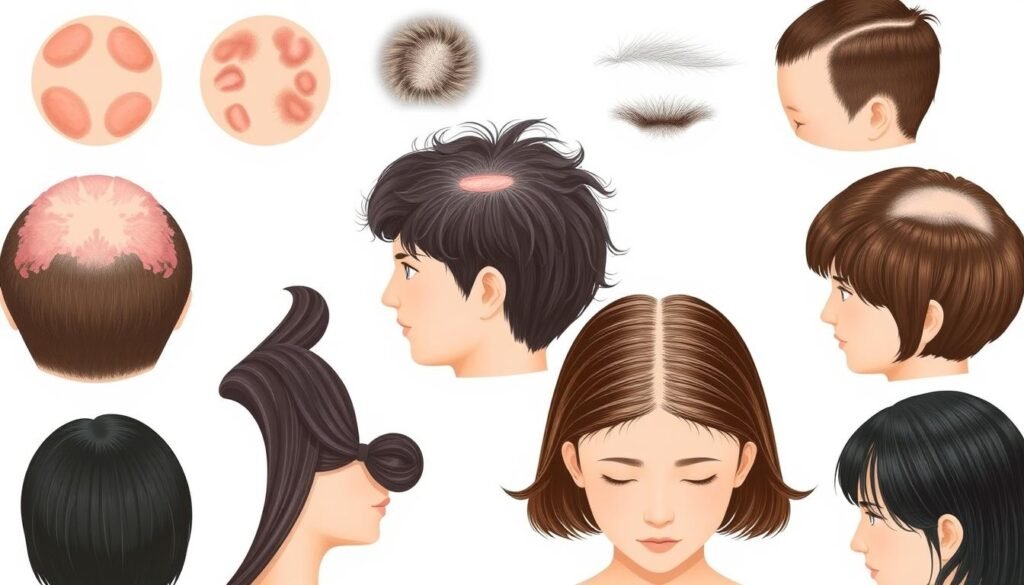Over 40 million people in the U.S. experience hair loss. It’s known medically as alopecia. This condition can show up in many ways and affects people of all ages and genders. There are several types of alopecia, such as alopecia areata, androgenetic alopecia, and scarring alopecia. Knowing about them is vital. It helps in recognizing hair loss patterns and exploring treatment options.
This overview of alopecia breaks down the complexities. It details causes, symptoms, and who it affects. The goal is to inform readers about the options they have.
Key Takeaways
- Alopecia encompasses various types that can affect anyone.
- Understanding the specific types of alopecia is crucial for effective management.
- There are both nonscarring and scarring forms of alopecia.
- Treatments vary and include options like corticosteroids and immunosuppressive drugs.
- Patterns of hair loss differ significantly between men and women.
- Hair restoration techniques are available for different types of hair loss.
Alopecia: An Overview
Alopecia is when people lose their hair in areas where it usually grows. It means the absence or loss of hair. The alopecia overview shows this can be small patches or all over. It might be forever or just for a while. Losing hair can really affect how someone feels about themselves.
Defining Alopecia
Alopecia includes different types of hair loss. Nonscarring alopecia is seen in 73% of cases. Androgenetic alopecia is the most common type, hitting 37.7% of people. Alopecia areata and telogen effluvium are next in line. Then there’s scarring alopecia, making up 27% of cases. Conditions like frontal fibrosing alopecia fall under this category. Knowing these types helps in finding the right treatment.
Importance of Understanding Hair Loss
Understanding hair loss is crucial. It helps people know why they’re losing hair and choose how to deal with it. Hair loss can really upset someone, making it essential to handle early. Knowing about it helps lessen these emotional struggles. It improves a person’s quality of life.
Types of Alopecia
Alopecia splits into two main types of alopecia: nonscarring and scarring. Knowing these helps in identifying the hair loss type and looking for treatments.
Nonscarring Alopecia
Nonscarring alopecia means hair follicles are intact. So, there’s a chance for hair to grow back. Conditions like alopecia areata show patchy hair loss. Telogen effluvium leads to temporary thinning due to hair cycle changes.
About 90% of people with alopecia areata see their hair return in years. Knowing this can help in managing and treating the condition.
Scarring Alopecia
Scarring alopecia, however, damages hair follicles permanently. This means hair loss is permanent. Frontal fibrosing alopecia is one type, mostly seen in women around menopause. Central centrifugal cicatricial alopecia often affects Black women.
Understanding these helps in seeking the right medical help. The National Alopecia Areata Foundation offers many resources for support.

Alopecia Areata
Alopecia areata is an autoimmune disorder that leads to patchy hair loss. People often find round or oval bald spots on their scalp or other body parts, like the beard and eyebrows. Knowing about alopecia areata helps us understand its effects and the psychological impact on those who have it. Around 2% of people worldwide are affected, which includes about 7 million in the U.S alone.
Characteristics and Symptoms
The main features of alopecia areata are:
- Patchy hair loss that can happen fast.
- It’s possible for hair to regrow, but hair loss might happen again.
- Along with hair loss, some feel tingling or see changes in their nails.
- Both men and women can get it, but it might be more common in women.
About 80% of people with alopecia areata see signs before turning 40. In that group, 40% notice symptoms by 20 years old. Family history matters, as 20% have a relative with the condition.
Different Variants of Alopecia Areata
There are several forms of alopecia areata, each with its own challenges:
- Alopecia totalis: This type causes complete hair loss on the scalp.
- Alopecia universalis: Here, people lose all hair over their entire body.
- Diffuse alopecia areata: This leads to thinning hair instead of patchy loss.
- Ophiasis alopecia: This results in hair loss in a band shape around the scalp’s sides and back.
Studies show alopecia areata is diagnosed more in Black, Asian, and Hispanic groups than in white ones. Genetics, the environment, and social factors likely play a role in these differences.

Androgenetic Alopecia
More than 50 million men and 30 million women in the United States struggle with androgenetic alopecia. It’s the top cause of hair loss. Males and females show different patterns of baldness. Men often get a specific pattern of loss, but women’s hair thins broadly without going fully bald.
Understanding Male and Female Pattern Hair Loss
By 50, up to half of all men face male pattern hair loss. This can hurt how they see themselves and lead to mental health issues. Women usually notice their hair thinning out after menopause. Such changes can be tough on anyone, especially if it starts early or gets bad fast.
Genetic and Hormonal Factors
About 80% of male pattern hair loss is down to genetics. Changes in the AR gene play a role in this. Hormones like dihydrotestosterone are also key players. Topical minoxidil and oral finasteride can slow hair loss. There’s new hope with dutasteride, which might work better for younger men.

Traction Alopecia
Traction alopecia happens when hair falls out because it’s pulled too tightly. Often, women of African descent are affected. Up to 31.7% of adult women might have hair damage from this. Knowing what causes traction alopecia helps fight its effects.
Causes of Traction Alopecia
Hairstyles like ponytails, buns, braids, and cornrows can lead to traction alopecia. Using hair extensions or weaves and tight rollers increases the risk. Even kids between 6 to 15 years old face this problem, with rates from 8.6% to 21.7%.
One study found that 18% of African American girls, aged about 5 to 14 years, had traction alopecia. Some kids as young as eight months old show symptoms, too.
Prevention Tips for Traction Alopecia
To prevent traction alopecia, try not to pull your hair tight. Wear your hair loose more often and change styles to avoid strain. Use soft hair ties to prevent damage. Those in ballet or gymnastics need extra care.
Keep styling heat low and avoid harsh chemicals. Knowing these tips helps keep your hair healthy.
If you’re looking for ways to treat hair loss, understanding treatment options is key. You can learn about treatments, including prescription options, here.
Telogen Effluvium
Telogen effluvium is a common kind of temporary hair loss. It happens when many hair follicles enter the resting phase too soon. This often leads to thinning hair, particularly in women aged 30 to 60. Knowing what causes telogen effluvium is key to dealing with it.
What Triggers Telogen Effluvium?
Different things can cause telogen effluvium, for example:
- Big stress from life or work problems
- Hormonal shifts, like during pregnancy or menopause
- Getting sick or having a major health issue
- Certain medications that mess with the hair growth cycle
Because of these triggers, up to 70% of a person’s growing hair might enter the resting phase. This can cause shedding of up to 300 hairs a day. Acute telogen effluvium, which lasts less than six months, accounts for 95% of cases.
Duration and Treatment Options
Dealing with telogen effluvium mostly means tackling its causes. Acute telogen effluvium usually gets better on its own in a few months. But, chronic telogen effluvium can last longer than six months and spread across the scalp. Though it’s not harmful to physical health, it can lead to emotional issues like stress or depression.
To manage telogen effluvium, one could:
- Try stress-busting activities such as yoga
- Eat a balanced diet rich in vitamins and minerals
- See a doctor to check for hormonal or thyroid problems
- Consider taking iron or other nutrients if needed
If you think you have telogen effluvium, it’s a good idea to get medical advice. Blood tests and scalp biopsies can confirm your condition. They also help find the best way to treat it. For more info on hair loss reasons, check out this helpful page.
Scarring Alopecia
Scarring alopecia involves conditions that destroy hair follicles permanently. It causes irreversible hair loss. Knowing about these types helps in their effective management. Conditions like frontal fibrosing alopecia and lichen planopilaris have unique symptoms and ways they progress.
Understanding Primary Scarring Alopecias
Primary scarring alopecias are rare. They greatly affect those who have them. Diseases such as folliculitis decalvans are included in this group.
These conditions often lead to:
- Scaling
- Redness
- Burning sensations
- Changes in pigmentation
We don’t fully understand what causes primary scarring alopecia. Diagnosis involves scalp biopsies and hair pull tests. These tests help us check the health of hair follicles. Treatment includes anti-inflammatory drugs and corticosteroids. The results of treatment can be different for everyone.
Conditions Associated with Scarring Alopecia
Scarring alopecia can also develop from other problems, like infections or injuries. Central centrifugal cicatricial alopecia is common among African descent females and might be inherited. It’s important to catch this condition early. If not treated, it can keep harming hair follicles.
Hair transplants may help recover hair in areas with scars. This works if there’s enough good hair to use and the hair loss causes are under control. Knowing the conditions associated with scarring alopecia helps people find the right help early.
Other Less Common Types of Alopecia
Alopecia has several types. Some are not well known but deeply affect those who have them. These include alopecia totalis, alopecia universalis, and chemotherapy-induced alopecia. Learning about these can help us understand hair loss better. It also shows us ways to manage it.
Alopecia Totalis
Alopecia totalis leads to no hair on the scalp. It is an autoimmune disorder. It can make people feel bad about how they look and feel inside. Getting help early is good. Studies show it might run in families. This means if someone in your family has it, you might get it too.
Alopecia Universalis
Alopecia universalis causes loss of all body hair. It happens when the body fights its hair follicles by mistake. People with this condition often face hard emotional challenges. Getting emotional support and finding a community are key.
Chemotherapy-Induced Alopecia
About 65% of cancer patients lose hair because of treatment. This hair loss can start soon after treatment begins. Hair growing back is often seen as a hopeful sign. Those with this type of alopecia find help in counseling and support groups.
Conclusion
Learning about alopecia is very important for people who are losing hair. It’s essential to know the different kinds of hair loss. There are many types, like the common male and female pattern hair loss. Also, there’s alopecia areata, which is an autoimmune issue. Knowing about each type helps in handling the problem better.
Getting diagnosed early can lead to better ways to deal with hair loss. If you are worried about losing hair, you should talk to a doctor. Dermatologists are experts who can suggest the best treatments after looking at your health history. Treatments range from medicines like minoxidil and finasteride to hair transplant procedures. These options offer hope for managing hair loss well.
Understanding alopecia can ease the stress and worry that comes with losing hair. Learning about treatment choices helps in fighting hair loss effectively. When you know what’s happening, you can take steps to feel better about how you look. Keeping up with new information on hair loss treatment can help people find the best care.